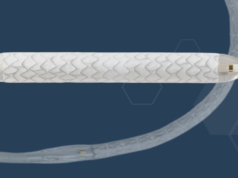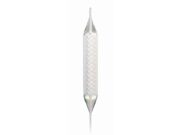This advertorial is sponsored by Getinge.
 Alan Lumsden, MD, Jean Panneton, MD, and Hiranya Rajasinghe, MD, detail the hemostatic and minimally thrombogenic benefits of the Fusion Bioline vascular graft.
Alan Lumsden, MD, Jean Panneton, MD, and Hiranya Rajasinghe, MD, detail the hemostatic and minimally thrombogenic benefits of the Fusion Bioline vascular graft.
With a heparin-bonded luminal vessel surface of minimally thrombotic polytetrafluoroethylene (PTFE) and an outer surface of highly thrombogenic polyethylene terephthalate (PET), Getinge’s Fusion Bioline expanded-PTFE vascular graft has demonstrated remarkable benefits in time-to-hemostasis compared with standard PTFE grafts for peripheral bypasses, according to Alan Lumsden, MD, medical director at Houston Methodist DeBakey Heart and Vascular Center at The Methodist Hospital in Houston.
Lumsden brings perspective drawn from twin vantage points. When he arrived in Houston to practice vascular surgery, he first worked under the cardiovascular colossus and medical device pioneer Michael DeBakey, MD, who, Lumsden points out, was the first to use a Dacron, or polyethylene terephthalate (PET), graft.
Lumsden was also a lead investigator in the randomized controlled trial (RCT) comparing the safety and efficacy between Fusion Bioline and standard ePTFE grafts for femoropopliteal bypasses, known as the FINEST trial. The RCT probed durability and effects on suture hole bleeding.
 “With the Fusion Bioline graft, platelets and red cells see minimally thrombogenic PTFE on the luminal surface, while on the outer surface they see highly thrombogenic PET,” explains Lumsden. “The question was: Could that help the suture hole bleeding? Would this compromise the durability of these grafts? That was what the FINEST trial was really all about. We were not so much trying to show that the Fusion Bioline graft had more durability than an equivalent heparin-bonded PTFE graft, but that it was at least equivalent in durability. And, number two—does it decrease the amount of needle hole bleeding? It turns out that there is equivalence in terms of the durability and there’s a marked decrease in the amount of bleeding.”
“With the Fusion Bioline graft, platelets and red cells see minimally thrombogenic PTFE on the luminal surface, while on the outer surface they see highly thrombogenic PET,” explains Lumsden. “The question was: Could that help the suture hole bleeding? Would this compromise the durability of these grafts? That was what the FINEST trial was really all about. We were not so much trying to show that the Fusion Bioline graft had more durability than an equivalent heparin-bonded PTFE graft, but that it was at least equivalent in durability. And, number two—does it decrease the amount of needle hole bleeding? It turns out that there is equivalence in terms of the durability and there’s a marked decrease in the amount of bleeding.”
Relevant results from the trial showed a primary patency rate at six months of 86.4% for the group implanted with a Fusion Bioline graft, compared with 70% for patients treated with a standard ePTFE graft (95% confidence interval [CI], 2.7–29.9; p=0.006). At 12 months, the patency rates were 76.5% and 67.0%, respectively (95% CI, -4.8–23.0; p=0.05).
“When you compare Fusion Bioline to some of the stents put in, they perform remarkably well,” comments Lumsden.
In terms of heparin elution, he explains the healing process after graft implantation. “Some healing occurs at the peri-anastomotic area—in other words where you actually sew the graft onto the native artery,” he says. “That is the area where grafts can thrombose, and the idea is that when you put these grafts in, this is where they are probably most susceptible to thrombosis. This is why you want the heparin bonding to be maintained—and most of that heparin is on there for a long time. The neat thing about this graft is that on the luminal surface you have an anticoagulant—heparin—bonded to a minimally thrombotic PTFE. With both of those things you would worry about needle-hole bleeding. And that’s the other nice thing about the Fusion Bioline: On the external surface, you’ve got pro-thrombotic activity.”
Key data from the FINEST trial demonstrated mean time to hemostasis of bleeding at the suture hole was 3.5 minutes in the Fusion Bioline group of patients and 11 minutes in the standard ePTFE group (p<0.0001).
Lumsden recalls using a stopwatch as an objective means of measurement. “Essentially, you sew the anastomosis, you release the flow, and you measure the time to hemostasis—and that’s done with a stopwatch,” he says. “I’ve been in rooms where this can go on for 35–40 minutes. So that’s really very good. And if you compare the Fusion Bioline with the non-Fusion grafts, there was a highly significant difference between the two. That’s the major point of interest for physicians.”
Jean Panneton, MD, professor of surgery, chief in the Division of Vascular Surgery at Eastern Virginia Medical School in Norfolk, Virginia, and a FINEST trial co-investigator, has routinely used the Fusion Bioline graft since it first cleared Food and Drug Administration 510(k) in 2013. Panneton points out the graft’s high safety profile, saying, “In some ways, it’s probably the most technologically advanced vascular graft that we have because it combines three different characteristics.” Namely: The inner bioline coating of albumin and heparin, which helps prevent clotting.
Ultimately, Panneton views the intraoperative of “much less anastomotic bleeding as opposed to a pure PTFE graft” as a chief benefit of Fusion Bioline: “If you have less anastomotic bleeding, you waste less time to achieve hemostasis, and you also end up using less hemostatic agent to try to help you get that hemostatic anastomosis.”
Ordinarily, Panneton would use smaller PTFE needles to obviate suture hole bleeding—or if operating in the neck he routinely deploys bio-glue—but he says using a bioline graft versus a pure PTFE graft “is another way to try to diminish the problem.” He points to the benefit provided by saving on operating room (OR) time. “OR time is precious because, one, it’s hard to have enough operating time as OR time is a precious commodity, and, two, for a hospital OR time is expensive, so every minute counts.”
Panneton adds that the time to hemostasis working with the Fusion Bioline graft, as reported in the FINEST trial, was three times faster than a pure PTFE graft. “In some situations, you’re saving maybe 10 or 15 minutes of time. The other thing that was noted was half-usage of hemostatic agent compared to the pure PTFE grafts.”
Hiranya Rajasinghe, MD, a vascular and endovascular surgeon at The Vascular Group of Naples, Florida, lauds the technical benefits of Fusion Bioline grafts.
“We’ve certainly observed that there’s less suture line bleeding and pursuant to that less need for topical hemostatic agents, but I would say the biggest benefit is this: When you’re suturing surgical anastomoses, the use of vascular sutures pass through this graft nicely in a manner that resembles more of a autogenous graft and less of a prosthetic graft,” he says. “In the alternative grafts that we have had available to use prior to Fusion Bioline, we would simply reverse the coagulation that we give for the procedure, most commonly heparin, so we would reverse that with protamine and perhaps supplement with hemostatic agents on the site of the anastomosis to aid in reducing the amount of bleeding. So clearly, in the case of Fusion Bioline, there is less of a need, or sometimes, in fact, no need for either of that.”
Typically, Rajasinghe noted, his team waits anywhere from 7 to 11 minutes during which no other part of the procedure can proceed until hemostasis is achieved. “The advantage of, for example, the Fusion Bioline product by comparison is that you would perform the surgical anastomosis, and, if things go right, there’s no surgical bleeding, and all the other remaining steps of the operation can flow seamlessly.”












